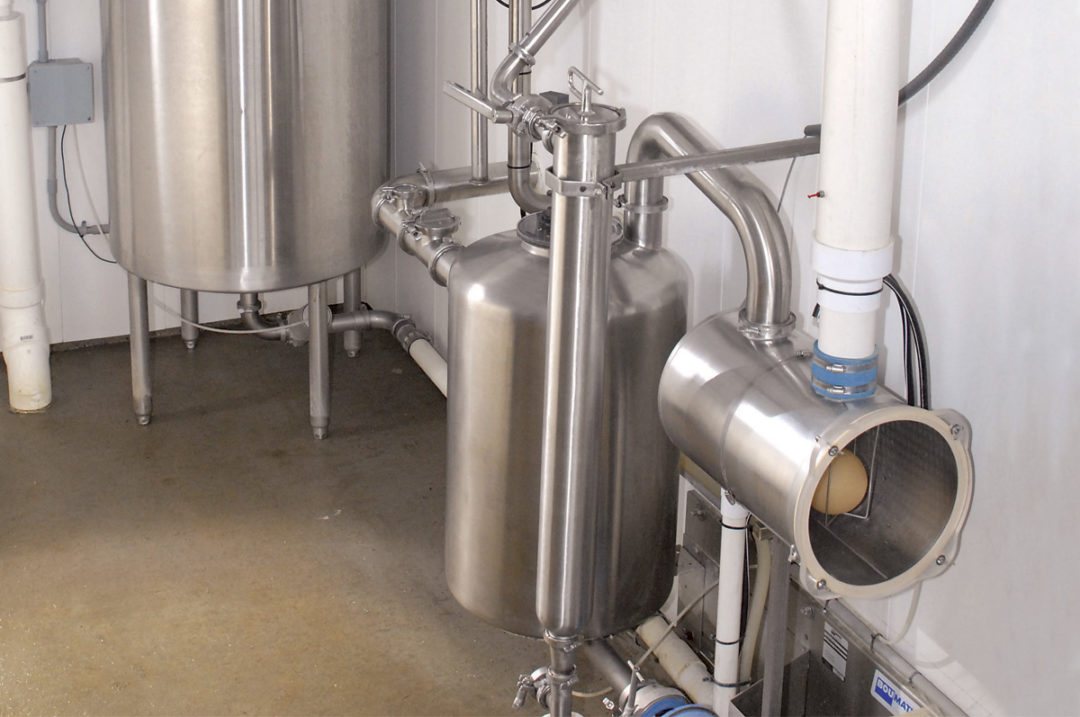To read this article in French, click here.
Keeping milking equipment clean is an essential part of producing the fresh, quality milk consumers expect. We want consumers to enjoy their dairy products and feel good about where they came from.
Producers can do this by creating a cleaning process that is efficient and effective. The steps outlined in this article should be used to ensure the cleanliness of your milking system.
Step 1: Have hot, quality water
Water is the main cleaning component of any wash. It makes up about 99% of the cleaning solution. With quality water, dairy producers can save on chemical costs because they are not fighting impurities in the water.
To test the water, have your dealer send in samples. The water on the dairy should have:
- Low hardness of 1 to 6 grain per gallon (gpg)
- Buffers in a range of 0 to 300
- Total dissolved solids (TDS) from 0 to 500 parts per million (ppm)
If there is a need to improve water quality, there are options. Softeners and filters are the least expensive, but what should be used depends on what needs fixing. If the water has high iron, you can use an iron filter. If hardness is high, a water softener is a good option. If TDS is over 500 ppm, the water needs a detergent with high sequestration levels.
Dairy producers should also focus on having hot water. When I visit dairies, I often see undersized hot water storage or a system that needs updating. Both greatly impact the cleanings.
My first recommendation is to ensure hot water storage is properly sized for the dairy. A good rule of thumb is 3.5 to 4.5 gallons of water per stall position, but there are other factors that affect the final number.
Secondly, if the dairy is in a high hardness or TDS water area, check the water heaters and storage for limestone buildup. If your storage is full of limestone, it may not heat the water as it should or have the hot water capacity it once had. If needed, replace or flush them.
Step 2: Use an effective cleaning process
When it comes to cleaning, there are four primary cycles in a conventional wash:
- Prerinse
- Detergent
- Acid rinse
- Sanitizing
The prerinse cycle does about 85% of the cleaning. During this step, warm water (90-120ºF) will run through the line and into the drain to get the majority of the milk out of the lines. Do not recirculate the water; you should see fairly clean water at the end.
Next is the detergent cycle. For this step, the water should be as hot as possible. I recommend 165-180ºF. This cycle includes alkaline and chlorine. Alkaline cleanses the system of fat deposits while chlorine breaks down protein. There are various products one can use, but it will depend on the water quality to determine which is the best fit.
The most important thing in the detergent cycle is draining the system at 125ºF or hotter. If the water is lower than 120ºF, fat will deposit back onto the stainless steel surfaces.
Next is the acid rinse. Cold tap water can be used for this cycle. The main purpose of this step is to break down minerals and put the milk line into a bacteria-static environment. It also neutralizes chlorine in the system to slow rubber breakdown.
The final step is the sanitizing cycle. This should be done less than an hour before milking with cold water and an EPA-approved sanitizer. For example, if you use a 12.5% EPA-registered chlorine, the sanitizing level the EPA recommends is 200 ppm.
Step 3: Watch and listen to the cleaning system
Equally important is making sure the cleaning system is working right mechanically. Start with the air injector. The air injector forms slugs through the system to clean the pipeline. Maintaining and servicing the air injector on a regular basis makes a difference. I recommend servicing it on an annual basis.
There are some things to watch and listen for. Listen for when the air injector opens up and for how long. There should be three slugs per minute in a well-maintained cleaning-in-place (CIP) wash. Second, the speed of the slug should be 23 to 30 feet per second for proper cleaning. Hearing the injector open and close is good.
Also, watch the receiver. When slugged water comes into the receiver, it should be one uniform block. If you see broken-up water or no water returned, something is wrong.
Check the gaskets and jetters. Worn-out jetters can leak air in. Leaking air will cause temperatures to drop faster than normal and can affect the slug required for cleaning.
If something does not seem right, call your dealer. Your dealer will be able to help you understand the system and how to keep your air injector properly set up. A good relationship with your local dealer is key to a high-functioning parlor. Make sure you are on the same page to keep the system running efficiently.
Step 4: Always run wash cycles supervised
There is a lot to do on the dairy, but I also believe there is great benefit in running wash cycles with someone watching them. I often hear of producers who set their parlors up to be cleaned, start the wash, go off to do other work on the farm and come back to a wash that did not run correctly.
Have someone be accountable for all washes. This will help prevent simple failures like a hose coming off or a jetter tray not being properly placed. A simple error can easily lead to losing control of consistent, quality washes.
Step 5: Have a professional wash analysis done
If you are not already having a wash analysis done by your dealer, consider doing so. The best practice is to have a professional analysis done on a regular basis.
Some dairies have an analysis done every month to keep up with quality numbers. Other dairies prefer quarterly or every six months. How often you have a wash analysis performed depends on your dairy’s goals. You may also want to test more if you have been seeing issues with the system.
Dairy producers can also do quick checks on their own using pH strips. When testing the detergent cycle, a pH of 11 or 12 is desired. For the acid cycle, the pH should be between 2 and 4. On the chlorine rinse, a pH of 9 or 10 is preferred.
A clean milking system is essential for producing fresh, quality milk. By following these steps, dairy producers can ensure their milking system operates at its best. Start with high-quality water and use an effective cleaning process. Pay attention to the cleaning system and run supervised wash cycles.
Finally, do not forget to have a professional wash analysis done regularly. With these steps, you can have confidence that you are doing everything possible to keep the milking system clean and your dairy running smoothly.







